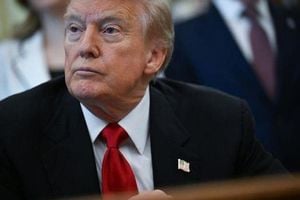In a moment described as "historic" by leaders at home and abroad, Victoria has become the first Australian state to sign and formalize a treaty with its Indigenous peoples, marking a major milestone in the nation's ongoing reckoning with its colonial legacy. On November 13, 2025, after nearly a decade of consultation and negotiation between the Victorian government and Indigenous leaders, the 34-page treaty was signed into law at Government House in Melbourne—a place that sits on the traditional lands of the Wurundjeri and Bunurong peoples.
The treaty, which has been applauded internationally, represents a significant step toward justice and reconciliation for Australia’s First Peoples. According to ABC News, United Nations Human Rights Chief Volker Türk called the agreement a "very significant moment for all Australians," adding, "It represents a major step toward justice and equality. It addresses the continued exclusion of and discrimination against the country's First Peoples—the result of colonisation." He expressed hope that this move would inspire other leaders in Australia and beyond to adopt similar measures, promoting societies built on mutual respect and human rights for all.
For many Indigenous leaders and advocates, the day was filled with emotion, pride, and a sense of relief. Mick Gooda, a Yiman and Ghangulu man who has spent decades advocating for Aboriginal and Torres Strait Islander rights, told ABC News, "Finally the government's taken notice of what Aboriginal people need to move forward and they've done it." Gooda emphasized the importance of this moment as a lesson for the rest of Australia, remarking, "The world hasn't changed that much, and all it means is that Aboriginal people have been recognised in Victoria, and that's a lesson for the rest of Australia."
Aunty Jill Gallagher AO, a proud Gunditjmara woman and former Commissioner of the Victorian Treaty Advancement Commission, played a pivotal role in the negotiations. Arriving at Government House on the morning of the signing, she shared with ABC's AM program, "I feel very happy. I'm just over the moon. I didn't think that I would ever see the signing of a treaty in this country—let alone in Victoria—in my lifetime." Gallagher also reflected on the bittersweet nature of the occasion, thinking of those who had fought for this moment but would not live to see it. "My mum is still alive [but] she's getting really unwell and she won't get to see this—or feel the impacts that treaty will have. That made me feel sad," she said. "[But] it's an exciting moment, it's an historic moment and all Victorians should rejoice in this."
The treaty’s signing ceremony brought together the co-chairs of Victoria's First Peoples' Assembly, the Victorian premier, minister for treaty, and the state’s governor, Margaret Gardner. Gardner described the occasion as "historic" and, upon announcing the Statewide Treaty Act as law, received a round of applause. "The first statewide treaty for Victoria, the first in Australia, and the first for First Peoples in Victoria," she declared, as reported by ABC News.
Premier Jacinta Allan spoke to the significance of the event, saying, "A chapter that brings together the oldest continuing cultures on earth with the more modern institutions of our state. It is a chapter that is founded on truth, guided by respect and carried forward through partnership ... a partnership to build a stronger, fairer, more equal Victoria for everyone. That's what treaty means."
The treaty document itself is a powerful statement of recognition and intent. As detailed by ABC News, it acknowledges the enduring connection of Aboriginal people to the land now known as Victoria, explicitly rejecting the colonial fiction that the land was "empty" before European arrival. The text draws on evidence from the Yoorrook Justice Commission, Victoria’s Aboriginal truth-telling inquiry, which found evidence of genocide, massacres, cultural destruction, forced child removals, and economic exclusion. The treaty notes, "Within two decades of colonisation, the [Victorian] population of First Peoples had reduced by nearly 90 per cent."
The agreement commits the state to confronting and accepting the "weight of this history," with the goal of addressing ongoing impacts and building a fairer future for all. As the treaty puts it, "It is a rare thing for a government to admit it was wrong—rarer still to commit, in plain words and enduring actions, to making it right. Yet that is what this moment asks. That is what this moment makes possible—a moment we claim together."
Victoria’s First Peoples' Assembly co-chair Ngarra Murray described the treaty as a "promise," saying, “Today marks a turning point in our nation's history, a moment where old wounds can begin to heal and new relationships can be built on truth, justice and mutual respect.” Co-chair Rueben Berg echoed this sentiment, emphasizing that the treaty is about more than symbolism: "This is a really powerful process to enhance the rights of First Peoples, and it's about getting better outcomes for First Peoples, which everyone should see as a positive thing."
Beyond words, the treaty establishes a range of commitments backed by state funding, including the creation of an Aboriginal authority controlled by elected Aboriginal Victorians, as well as new accountability and truth-telling initiatives set to launch in 2026. The agreement also introduces additional requirements for the Victorian government to consult with Aboriginal people on legislative reforms, aiming to "reset" the relationship between First Peoples and the state government.
Professor Tom Calma, speaking to ABC News Breakfast, highlighted the broader impact: "If you give Aboriginal and Torres Strait Islander people the opportunity to participate actively and equally in processes, we will see good outcomes. It is early days, but I think the foundations have now been laid and the commitment by the premier of Victoria to work with Aboriginal and Torres Strait Islander people, but also to fund the creation of the bodies ... needs to be recognised and I think congratulated."
However, the road ahead is not without challenges. The treaty, while supported by Victoria’s Labor government, faces political uncertainty. The state’s Liberal opposition has pledged to scrap the deal if it wins the 2026 state election. There has also been criticism of the government’s announcement, just a day earlier, of a new policy allowing children as young as 14 to face adult jail time for certain violent crimes. Victorian Aboriginal Legal Service CEO Nerita Waight described the policy as "cruel" and at odds with the spirit of the treaty, stating, "The treaty will ensure that what happened yesterday doesn't happen again where our experts are left unconsulted, where we are not acting on best evidence." Senator Lidia Thorpe added that such measures would disproportionately affect Aboriginal youth, questioning the hope offered by the treaty if punitive policies persist.
Despite these tensions, the mood among many Indigenous leaders and their allies is one of hope and determination. As Rueben Berg put it, "For future generations, we don't have to worry so much about having to campaign for these rights. We can actually exercise those rights." A public celebration of the treaty’s signing is scheduled for December 2025, offering Victorians a chance to mark this turning point together.
Victoria’s treaty stands as a testament to resilience, dialogue, and the enduring push for justice. While much work remains, the agreement has set a new course—one that recognizes the pain of the past while striving for a more equitable future.




